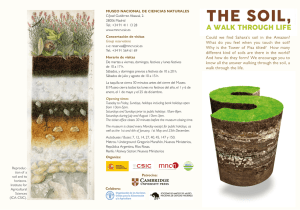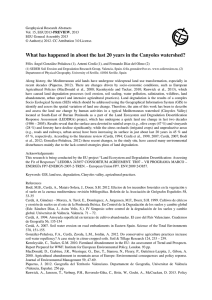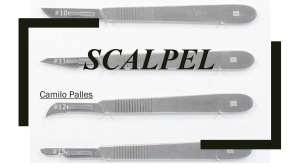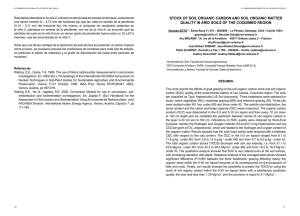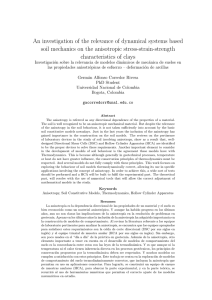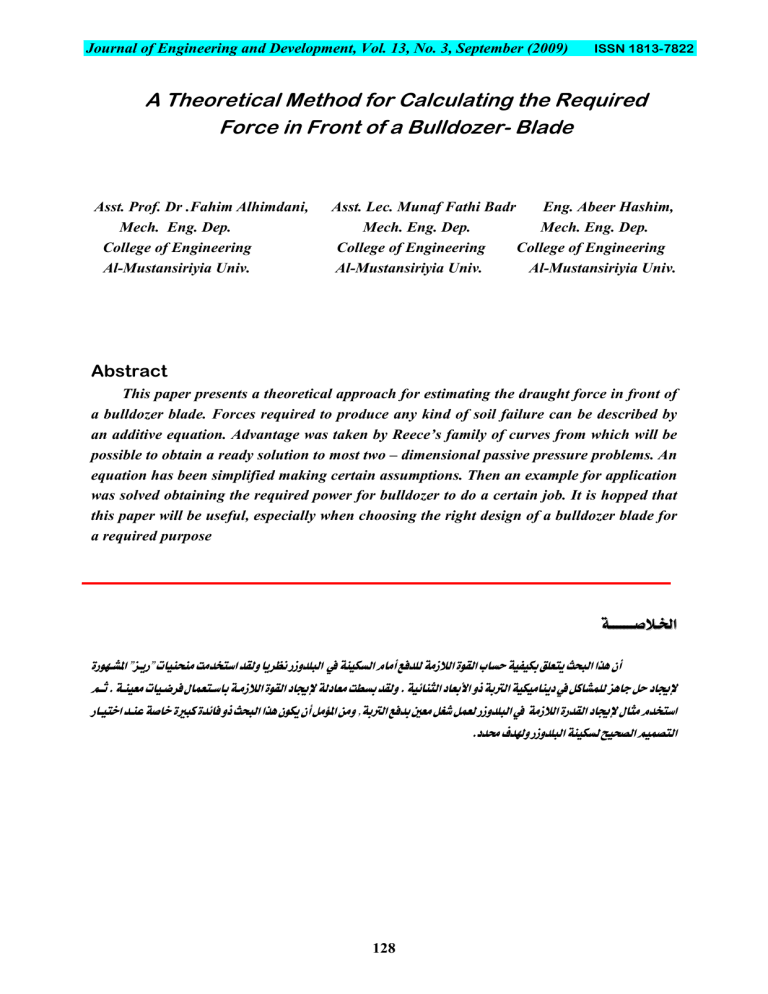
Journal of Engineering and Development, Vol. 13, No. 3, September (2009) ISSN 1813-7822 A Theoretical Method for Calculating the Required Force in Front of a Bulldozer- Blade Asst. Prof. Dr .Fahim Alhimdani, Mech. Eng. Dep. College of Engineering Al-Mustansiriyia Univ. Asst. Lec. Munaf Fathi Badr Eng. Abeer Hashim, Mech. Eng. Dep. Mech. Eng. Dep. College of Engineering College of Engineering Al-Mustansiriyia Univ. Al-Mustansiriyia Univ. Abstract This paper presents a theoretical approach for estimating the draught force in front of a bulldozer blade. Forces required to produce any kind of soil failure can be described by an additive equation. Advantage was taken by Reece’s family of curves from which will be possible to obtain a ready solution to most two – dimensional passive pressure problems. An equation has been simplified making certain assumptions. Then an example for application was solved obtaining the required power for bulldozer to do a certain job. It is hopped that this paper will be useful, especially when choosing the right design of a bulldozer blade for a required purpose @ @ò•ý¨a @ñ‰ìè’½a@BŒ@ í‰B@pbîäzäß@o߆‚na@†ÔÛë@bíŠÄã@‰‹ë†ÜjÛa@@¿@òäîØÛa@âbßc@ÉφÜÛ@òß‹ýÛa@ñìÔÛa@lby@òîÐîØi@ÕÜÈní@szjÛa@aˆç@æc@@@@@@@@@ @áq@N@òäîÈß@pbÏ@ÞbàÈnbi@ @òß‹ýÛa@ñìÔÛa@…b¯⁄@òÛ…bÈß@oİi@†ÔÛë@N@òîöbärÛa@…bÈiþa@ë‡@òiÛa@òîØîßbäí…@¿@Ý×b’àÜÛ@Œçbu@Ýy@…b¯⁄ @‰bîna@†äÇ@ò•b@ñj×@ñ†öbÏ@ë‡@szjÛa@aˆç@æìØí@æc@Ýßû½a@åßë@~òiÛa@Éφi@´Èß@ÝÌ‘@ÝàÈÛ@‰‹ë†ÜjÛa@¿@@òß‹ýÛa@ñ‰†ÔÛa@…b¯⁄@Þbrß@ↂna N…†ª@Ò†ë@‰‹ë†ÜjÛa@òäîØÛ@|îz–Ûa@áîà–nÛa 128 Journal of Engineering and Development, Vol. 13, No. 3, September (2009) ISSN 1813-7822 1. Introduction A bulldozer is a powerful crawler such as caterpillar tracked tractor equipped with a blade .Tires could replace the track for quick operation. The term bulldozer often used to denote any heavy engineering vehicle although the term officially relates to the dozer blade installed on tractor. The most common usage of the term bulldozer is to denote a tractor (most often tracked) equipped with a blade. The first bulldozer was adapted from frame tractors that were used to plough fields. In order to dig canals, raise earthen dams, and do other earth moving projects, the tractor was equipped with a large thick metal plate. This thick metal plate, it got its curved shape is called a "blade"[1, 2]. Figure (1): Tracked-type Bulldozer Through the years, bulldozers got bigger, more powerful, and more sophisticated. The dozer blade is a piece of heavy metal plate, installed on the front of the tractor , with the aim of pushing things , handle rough obstacles and shoving sand , dirt and debris . Bulldozer can be found on large and small scale construction sites, mines, roadsides, military bases, heavy industry factories and large governmental projects [3, 4, & 5]. 2. Theory The accurate evaluation of earth pressure on bulldozer blade is of a considerable importance in investigations concerned with soil implemented and soil vehicle mechanics [6, 7, &8] . Reece's has postulated an equation which can be written as follows [9]:- P = γ z² Nγ+ czNc+ ca zNa+ qzNq Where c = apparent cohesion, N/m². ca = soil- interface adhesion, N/m². Nγ,Nc,Na,Nq = dimensionless Reece factors . 129 ------------------------- ….(i) Journal of Engineering and Development, Vol. 13, No. 3, September (2009) ISSN 1813-7822 P q = soil reaction per unit width of interface, N/m. = surcharge pressure on soil free surface, N/m². The four terms in this equation represent the gravitational, cohesive, adhesive and surcharge components of the soil reaction per unit width of interface respectively. The Nfactors in equation (i) represent pure numbers, which are dimensionless Reece factors. These numbers describe the shape of the soil surface and thus function of angle of sharing resistance φ, and soil interface friction angle δ and the geometry of the loaded interface. Reece's equation applies to all forms of soil failure where deformation takes place slowly as in bulldozer blades. Thus inertia forces can be neglected .Re - arranging equation (i) P = z [γ z Nγ+ cNc+ ca Na+ qNq] -------------------------------------…. (ii) For simplicity the adhesive components of equation (ii) will be ignored for the time being. This is because it has assumed a very smooth blade as a new design is used. So, as a result, a very simple equation will be obtained as follow:- P = z [z γNγ + cNc+ qNq] …. (1) A simplified failure pattern for calculating the draught of a bulldozer is shown in figure (2). Figure (2): Simplified Failure Pattern for Calculating the Draught of a Bulldozer Frictional force =µ × Normal reaction Where µ = tan ϕ = H V = V H 130 Journal of Engineering and Development, Vol. 13, No. 3, September (2009) ISSN 1813-7822 Where H, V& V are forces shown in figure (2). If W 1 is the weight of soil triangle per unit width, then W 1 =V +V =V + H tan ϕ =V +V tan ϕ tan ϕ ∴W 1 =V [1 + tan 2 ϕ ] . …. (2) Also W 1 = Area of triangle× γ -------------------------------------If W 2 is the soil weight per unit width above rupture distance …. (3) (AD), then W 2 =Rupture distance (AD) ×Height × density (γ) The values of dimensionless Reece's factors can be calculated as follows:φ is represented by a family of curve increasing in steps of 5° to 45° and δ is accounted for only two specific values (δ=0 and δ = φ) .Two main interpolations are required to cover the N – factors at intermediate values of both φ and δ. The following relation ship can be established [10] for the required value of appropriate Nfactors and using N-factor curves which are shown in figures (3,4,5,6,7,&8). δ ϕ N N δ = N δ =0 δ =ϕ --------------------------------------------…. (4) N δ =0 Interpolation for δ in the range 0<δ<φ can thus be carried out with reasonable accuracy from eqn. (4) The distance (AD) has been designated the "rupture distance" is often required in the analysis of soil failure problems .The following required rapture distance ratio is calculating from figure (9) m m δ = m δ =0 δ =ϕ m δ =0 δ ϕ -------------------------------------------- …. (5) 3. Example of application Since equation (1) can be used to compute the forces involved in the failure of any mass of soil, the values of the N- factors presented in this paper will provide the basis for the solution of number of practical problems. As a typical example, the following soil &blade values are used Soil properties: φ = 32°, c = 8.63 kN/m², γ =17.95 kN/m³ Soil – Metal values: δ=11°, Blade geometry: z = 0.15m, total height = 1.14m, width = 4.6m, α =57° The value of Nγ when δ = 0 was found equal to 1.25 from figure (3) While the values of Nγ when δ =φ was found =2 from figure (4) 131 Journal of Engineering and Development, Vol. 13, No. 3, September (2009) ISSN 1813-7822 And as a result, the actual required value of Nγ when δ=11 is found using eqn. (4) by method of interpolation therefore 11 2 Νγ = 1.25 1.25 32 = 1.47 Nγ α degreee Figure (3) Relationship between Nγ and α when δ=0 Nγ α degreee Figure (4) Relationship between Nγ and α when δ=φ 132 Journal of Engineering and Development, Vol. 13, No. 3, September (2009) ISSN 1813-7822 Similarly the value of Nc for δ=0 was found =1.98 using figure (5) .While the value of Nc for δ=φ was found =3.6 using figure (6) Nc α degreee Figure (5) Relationship between Nc and α when δ=0 Nc α degreee Figure (6) Relationship between Nc and α when δ=φ 133 Journal of Engineering and Development, Vol. 13, No. 3, September (2009) ISSN 1813-7822 Hence, the required value for Nc was calculated as before using eqn (4), and which is Nc = 2.43 .Similarly the value of Nq when δ = 0 was found = 2.5 from figure (7) While the value of Nq for δ = φ was found = 4 using figure (8) Nq α degreee Figure (7) Relationship between Nq and α when δ=0 Nq α degreee Figure (8) Relationship between Nq and α when δ=φ 134 Journal of Engineering and Development, Vol. 13, No. 3, September (2009) ISSN 1813-7822 And as before, the required value for Nq was calculated using eqn (4) which is Nq = 2.94 .To summarize the values of the N- factors obtained by the method of interpolation are given in table (1) Table (1) Interpolated N-values Interpolated for φ= 32° Interpolated for δ = 11° (eqn.(4) ) Nδ = 0 Nδ =φ Calculated N Gravitational (Nγ) 1.25 2.00 Nγ = 1.47 Cohesive (Nc ) 1.98 3.60 Nc = 2.43 Surcharge (Nq) 2.50 4.00 Nq = 2.94 Finally the rapture distance ratio was found using figure (9) m δ=0 m δ=φ α degreee Figure (9) Mean Ratio of Rupture Distance to Depth when δ=0 (top) and δ= φ (bottom) 135 Journal of Engineering and Development, Vol. 13, No. 3, September (2009) ISSN 1813-7822 The rupture distance ratio (m) has been interpolated from Eqn. (5) ( m = 2.45 2.70 2.45 ) 11 32 = 2.54 The rapture distance (AD) = m × z = 2.54× 0.15 =0.381 m From dimensions given in fig (2) the following value can be computed for unit width of blade W 1 = Area of triangle ×γ Where the height of triangle = height of blade – depth of blade = 1.14 -0.15 = 0.99 m 0.99 The base of triangle = = 1.58 m 0.99 tan ϕ 1.58 × 0.99 × 17.95 = 14 kN m 2 From eqn. (2) W1 V = 1 + tan 2 ϕ ∴W 1 = W1 φ 1.58 14 =10 kN m 1 + tan 2 32 W2 = (AD) × height × γ = 0.381×0.99×17.95 = 6.75 kN/m = q = W2 +Vtanϕ ( tanϕ + tanδ ) /(AD ) = 31.15 kN/m² Substituting these values in eqn (1) The total draught per unit width is equal to:P sin (α +δ) + V tanφ ∴ Total draught force D = [(z² Nγ+ czNc+ qzNq) × sin (α +δ) + V tanφ] ×width = 103.28 kN If an assumed average speed of bulldozer is 5 km/h, then the required horsepower to do this job is =103.28 ×10³× (5 /3.6) Nm/s =143.4 kW (188 Hp) 4. Conclusion It has been shown with given data of soil and Bulldozer blade shape, the total required draught force can be calculated theoretically. This was accomplished using valuable Reece’s family of curves which have been already well established. Thus the required horse power for bulldozer to push soil in front of the blade can be estimated given the speed of the bulldozer. Regarding this work there are almost no published papers or research activities have been done in Iraq. Therefore and as a result, it is hoped that this paper with the given example will be useful in selecting the optimum design for a required job. 136 Journal of Engineering and Development, Vol. 13, No. 3, September (2009) Notations c = apparent cohesion, N/m². ca = soil- interface adhesion, N/m². (AD) = rupture distance, m. m = ratio of rupture distance to depth of cut. Nγ,Nc,Na,Nq = dimensionless Reece factors. P = soil reaction per unit width of interface, N/m. q = surcharge pressure on soil free surface, N/m². = weight of soil triangle per unit width in front of Bulldozer, N/m. W1 W2 W z α γ δ φ µ H V V = weight of soil above rupture distance (AD) per unit width, N/m. = W1 + W2 , N/m. = depth of cut, m. = rake angle of interface, deg. = bulk density of soil, N/m³. = angle of soil – interface friction, deg. = angle of sharing resistance, deg. = coeff .of friction between soil layers. = horizontal reaction per unit width between blade & soil, N/m. = vertical reaction of soil triangle per unit width, N/m. = frictional force between soil triangle &soil prism per unit width, N/m. D = total required draught force, N. 137 ISSN 1813-7822 Journal of Engineering and Development, Vol. 13, No. 3, September (2009) ISSN 1813-7822 5. References 1. F.Malaguti." Soil Machine Interaction in Digging and Earth Moving Automation." proceeding of 11th International Symposium on Automation and robotics in Construction. Brighton, UK. 24-26 may 1994. 2. P.vähä." Modeling and Control of Cognitive Excavation", Technical Report. Purdue University .October 1 .1990. 3. A.Hemami."Force Analysis in the Scoping / Loading Operation of an LHD Loader", Proc. of 2nd Int. symposium on mine mechanization and automation, pp 415-424, 1993. 4. E.Mekeys."Soil Cutting and Tillage, developments in agricultural engineering 7". Amsterdam, the Netherlands: Elsevier Science Publishers B.V.1985. 5. 15th ADAMS European Users Conference, Rome 2000-10-04 Digging forces in gravel, page 9. 6. E .Mckeyes &O.S.Ali," The Cutting of Soil by Narrow Blades". J. of Terramechanics, 1997, Vol.14, No.2, pp 43-58. 7. R.J.Godwin & G.Spoor."Soil Failure with Narrow Tines", Journal of Agric.Engng.Res. 1977, 22, pp 213-228. 8. "Active &Passive Earth Pressure Coefficients by a Kinematical Approach" Abdul-Hamid Soubra &Brout Macuh. Proceedings of the Institution of Civil Engineers, Geotechnical Engineering 155, April 2002, pp 119-131. 9. D.R.P.Hettiaratchi & A.R.Reece"the Calculation of Passive Soil Resistance" Geotechnique 24, no.3, pp289-310, 1974. 10. D.R.P. Hettiaratchi i & A.R.Reece" Symmetrical Three Dimensional Soil Failure" J. of Terramechanics, 1967, vol.4, No.3, pp 45-67. 138

